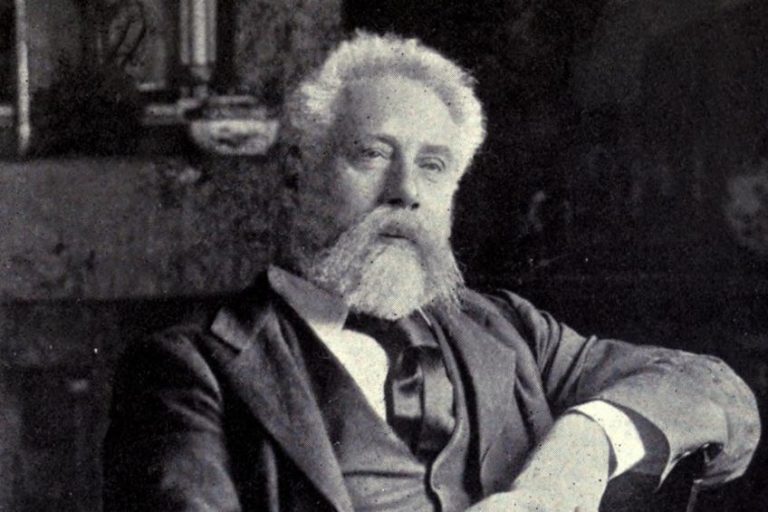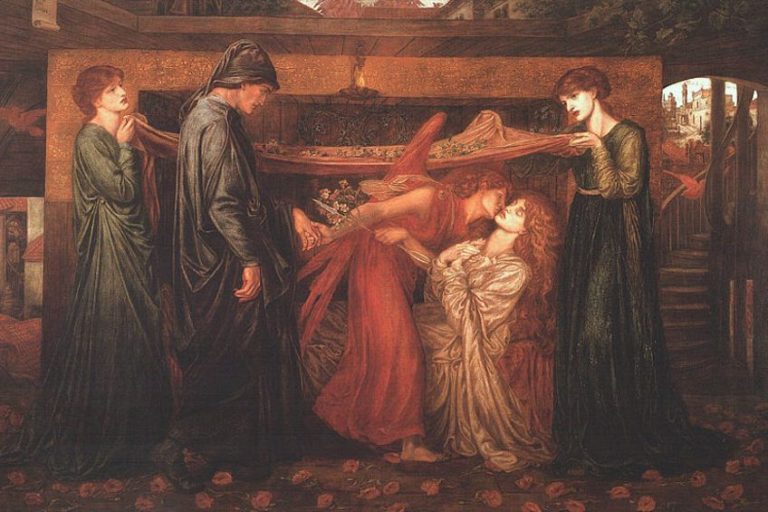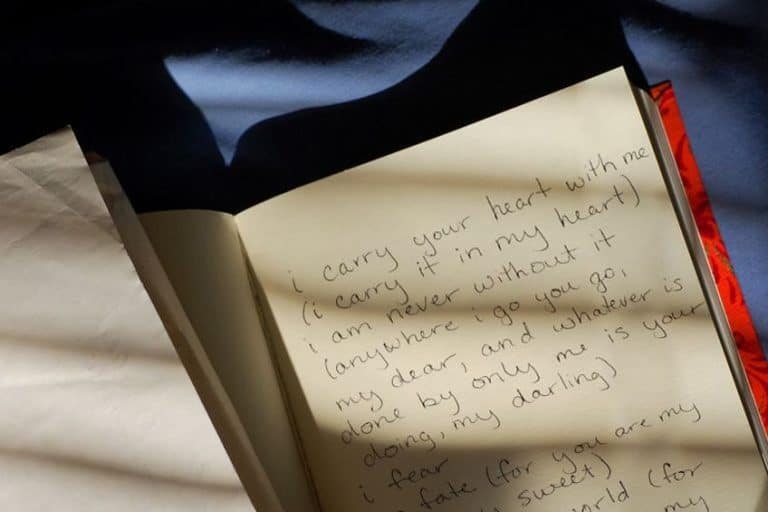Alliteration Poems – Discover Famous Poetry Examples
Alliteration in poetry is everywhere. This is an incredibly common poetic device, but that does not mean we should take it for granted. Instead, we should have a look at some poems with alliteration to see why this poetic device, with its repetition of consonant sounds, is used in so many poems. We are going to examine ten examples of alliteration in poetry in this article, and we will demonstrate how alliteration can be used in each of these poems. For those who find these kinds of devices interesting, let’s see where this list will take us. Perhaps you will even find some examples of alliteration in poetry that you are familiar with!
Table of Contents
- 1 A Look at Alliteration Poems
- 1.1 Sonnet 5: Those hours, that with gentle work did frame (1609) by William Shakespeare
- 1.2 The Rime of the Ancient Mariner (1798) by Samuel Taylor Coleridge
- 1.3 Peter Piper (1813) by John Harris
- 1.4 The Raven (1845) By Edgar Allan Poe
- 1.5 By night we linger’d on the lawn (1850) by Alfred Lord Tennyson
- 1.6 Because I Could Not Stop for Death (1890) by Emily Dickinson
- 1.7 Winter Snow (Between 1907 and 1933) by Sara Teasdale
- 1.8 Birches (1915) by Robert Frost
- 1.9 Anthem for Doomed Youth (1920) by Wilfred Owen
- 1.10 The Colossus (1960) by Sylvia Plath
- 2 Frequently Asked Questions
A Look at Alliteration Poems
When it comes to poems using alliterations, there are far too many examples out there to find. Alliteration is one of the most common poetic devices that can be used, and it can also be found outside of poetry. We, as humans, are usually interested in things that sound the same as one another. It’s the same reason that we like rhyme. Alliteration simply sounds good to the ear. For this reason, poems with alliteration account for a vast array of poems.
Now, for those who are unfamiliar with the concept of alliteration, this poetic device involves the repetition of consonant sounds.
Consonants are the opposite of vowels, and when someone repeats the vowel sounds, namely a, e, i, o, u, they are engaging in assonance. This kind of repetition is not as common as alliteration, because alliteration involves the repetition of every single other letter in the alphabet.

Strictly speaking, there is a distinction between alliteration and consonance. This is because consonance involves the repetition of consonant sounds anywhere in a word whereas alliteration refers to the use of the repetition of consonant sounds at the beginning of words. However, this article will include examples of both, because consonance can be found practically everywhere, and it can often sound undetectable to us.
For instance, the words “sound” and “undetectable” both include a repetition of a prominent “d” sound, yet most would probably not hear it as much. It’s far easier to hear something like “the steady sound swayed” or something similar.
With all of that out the way, let’s have a look at a list of poems with alliteration. We are going to examine some of the parts of these alliteration poems where this device is used and why it is used. There are many different reasons that there might be an example of alliteration in poetry. So, let’s see what some of those reasons will be and have a look at our first, and the oldest, example of alliteration in poetry on this list.
Sonnet 5: Those hours, that with gentle work did frame (1609) by William Shakespeare
| Date Published | 1609 |
| Type of Poem | Shakespearean sonnet |
| Rhyme Scheme | ABAB CDCD EFEF GG |
| Meter | Iambic pentameter |
| Topic | Time |
Those hours, that with gentle work did frame is not one of the most well-known sonnets by William Shakespeare, but it does make strong use of alliteration. The poem is focused on the way in which time passes us by and it reveals the way in which the seasons of the year can be compared to the stages of our lives.
There are instances of alliteration in this poem in lines like “beauty o’er-snowed and bareness every where” and “beauty’s effect with beauty were bereft”.
These lines show the way that the “b” sound can be continuously repeated to draw attention to the understanding of beauty and how it alters and shifts. Other instances include the use of phrases like “prisoner pent” and “substance still lives sweet”, and the last of these actually makes use of further consonance by incorporating an “s” sound into the end of “lives” to further add to the “s” sound.

The Rime of the Ancient Mariner (1798) by Samuel Taylor Coleridge
| Date Published | 1798 |
| Type of Poem | Lyrical ballad |
| Rhyme Scheme | ABAB |
| Meter | Iambic pentameter |
| Topic | Sailor |
The Rime of the Ancient Mariner is one of the most famous poems that Samuel Taylor Coleridge ever wrote, and it is about a sailor’s experiences on the sea. It is a long and dense poem that covers several topics over the course of the text, but it also serves as one of the best poems with alliteration.
The most basic of these is the repetition of the same words, or words that are connected to one another, such as “sun” and “sea”, but there are also lengthier alliterative sections.
Some of the alliterative sections of this poem enter during the wedding scene in which the “b” sound is repeated in “beat his breast”, “loud bassoon”, and “the bride”. All of these are used within three lines of one another. This calls attention to the specificities of the wedding itself, and it elevates the wedding into something that is notable within the narrative of the poem. This can also be seen in the use of phrases like “red as a rose” and “merry minstrelsy” in the same section.

Peter Piper (1813) by John Harris
| Date Published | 1813 |
| Type of Poem | Nursery rhyme |
| Rhyme Scheme | ABAB |
| Meter | Iambic hexameter |
| Topic | Tongue twister |
Peter Piper is an integral poem if one wants to talk about alliteration poems. This particular poem does not use alliteration as some kind of highlighting or emphasizing technique, but rather to create a tongue twister. Practically everyone knows this poem even if they do not know it word-for-word, but it has become a popular tongue-twister because it is simply entertaining to try and say without mixing up your words!
This makes this particular poem rather fun and challenging to pull off.
The poem is simply noted for its intensive repetition of the popping “p” sound. It is difficult to read aloud because of the intense repetition, and the idea is that you are supposed to say it as quickly as possible without making a mistake. The content of the poem is repetitious and does not matter. All that matters is if you can also recite that “Peter Piper picked a peck of pickled peppers”.

The Raven (1845) By Edgar Allan Poe
| Date Published | 1845 |
| Type of Poem | Narrative poem |
| Rhyme Scheme | ABCBBB |
| Meter | Trochaic octameter |
| Topic | Grief |
The Raven is one of the best examples of rhythmic poetry in general. The poem is a gothic tale about a raven that visits a grieving man in the dead of night and repeatedly says the word “nevermore”.
This torments the man as the ideas of death and memory are explored through this unusual and possibly supernatural encounter.
The poem is also incredibly rhythmic as it includes end-rhyme and internal rhyme, a highly repetitive structure, and extensive use of repetition, such as the phrases “weak and weary” and “nodded, nearly napping”. These are strong uses of alliteration and they add to the general uneasy atmosphere that the poem is attempting to produce for the reader.
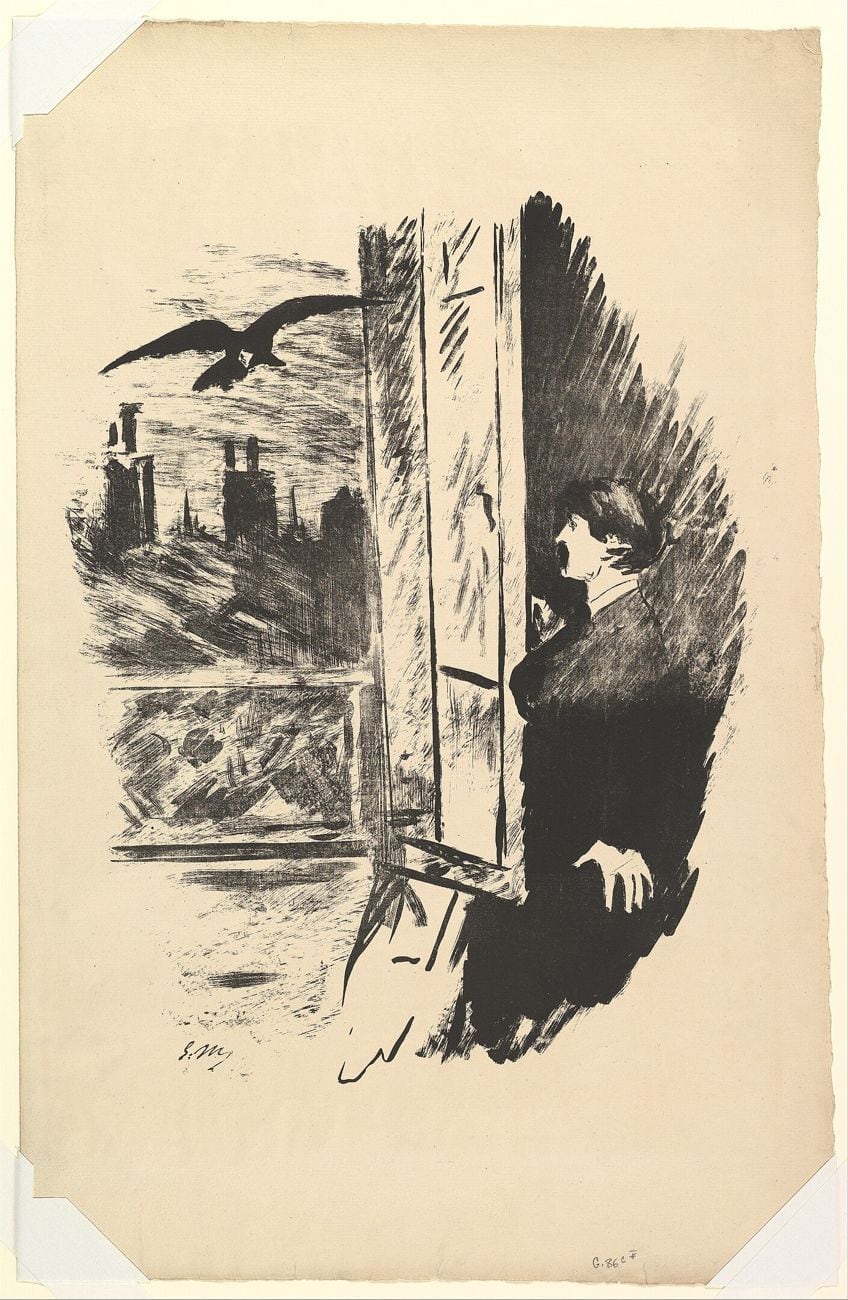
By night we linger’d on the lawn (1850) by Alfred Lord Tennyson
| Date Published | 1850 |
| Type of Poem | Elegy |
| Rhyme Scheme | ABBA |
| Meter | None |
| Topic | Love, sorrow, and rebirth |
By night we linger’d on the lawn is a superb poem by Alfred Lord Tennyson and is a strongly rhythmic and alliterative poem. It makes use of a variety of these techniques to produce a certain image of a natural landscape. Some of the lines that make use of alliteration are broken up and this allows for a more musical note as sounds are often repeated but not necessarily always beside one another.
Some examples of alliteration in this poem include phrases like “cricket chirr’d”.
This produces a natural and pleasant image, but there are also instances like the lines “the brook alone far-off was heard/And on board the fluttering urn”. These lines make use of “b” and “f” sounds that alternate with one another. They are disconnected enough to not sound like something highly alliterative, but are also close enough to one another to produce an image of natural beauty.
Because I Could Not Stop for Death (1890) by Emily Dickinson
| Date Published | 1890 |
| Type of Poem | Lyric poem |
| Rhyme Scheme | ABCB |
| Meter | Variable |
| Topic | Death |
Because I Could Not Stop for Death is a poem that must be mentioned when discussing alliteration poems as it makes extensive use of them. The poem concerns a journey to death, and there are various personified aspects of mythological origin along the way. The poem is also interesting in the oeuvre of Emily Dickinson because of its extensive use of capitalization.
The poem constantly draws attention to various images through the use of close-knit alliterative pairings.
This includes “Recess – in the Ring”, “Gazing Grain”, “Setting Sun”, “Dews drew”, “Gossamer, my Gown”, and “Tippet – only Tulle”. These do not form one phonetic sound that is repeated, but rather an array of sounds that are repeated enough to draw attention to each, but not to the whole. This is an interesting exercise in alliterative usage and one that makes this poem a particularly unique one.

Winter Snow (Between 1907 and 1933) by Sara Teasdale
| Date Published | 20th Century |
| Type of Poem | Lyric poem |
| Rhyme Scheme | ABCB |
| Meter | None |
| Topic | Change and aging |
Winter Snow is a beautiful poem and a fantastic example of alliteration in poetry. The poem makes use of highly poetic language to explore themes like aging and change. It depicts these things as something that is inescapable for us. We can fight against it, but there is little that can be done about such a thing.
However, this does not mean that it is a sad thing, but rather one that is hopeful as we can simply give in to our understanding of this.
The poem accomplishes this image with the use of various alliterative aspects, such as the use of the “w” sound in “windows”, “winter”, and “watched” over the course of three lines, as well as “dreaming my dreams” in one line. These kinds of alliterative uses allow us to focus on this wintery and dreamlike atmosphere. The winter nights are the most important things to consider in this poem, and they are often darker, and so the use of the “w” sound allows us to lead toward that darker and more depressive feeling.

Birches (1915) by Robert Frost
| Date Published | 1915 |
| Type of Poem | Narrative poem |
| Rhyme Scheme | None |
| Meter | Iambic pentameter |
| Topic | Birch trees |
Birches is a rather beautiful poem and a good example of an alliteration poem as it features strong usage of certain sounds to describe the way in which the birch trees bend with the storm. The poem is one that makes use of strong imagery to show this bending, but the bending is of central importance in this poem, and so the “b” sound is emphasized to ensure that the reader notes it.
The poem uses “birches bend”, “boy’s been”, “but”, and “bend them” over the course of four lines to strongly emphasize the “b” sound.
The reason for this is that poems using alliterations often do so because something in the poem needs to be highlighted, and we, as the readers, are expected to pay attention to the plight of the birches by constantly using the phonetic sound associated with these trees.

Anthem for Doomed Youth (1920) by Wilfred Owen
| Date Published | 1920 |
| Type of Poem | Sonnet |
| Rhyme Scheme | Variable |
| Meter | Iambic pentameter |
| Topic | War |
Anthem for Doomed Youth is one of the most important war poems of all time, and it is one of the best-known poems of Wilfred Owen. This poet was a wartime poet who fought in the First World War and passed away before the end of hostilities. His poems have become indicative of the kind of suffering that the soldiers were forced to endure as they fought, and this poem is no exception.
The poem makes use of alliteration because it emulates certain sounds that could be heard on the battlefield.
The best example makes use of both alliteration and consonance, and it is the lines “the stuttering rifles’ rapid rattle/can patter”. Here, we see that there is the repetition of the “r” sound in “rifles’ rapid rattle” alongside the consonance of the “t” sound in “stuttering”, “rattle” and “patter”. This makes it sound like gunfire, and as these soldiers would be consonantly hearing gunfire around them, the use of this sound is a poignant one.
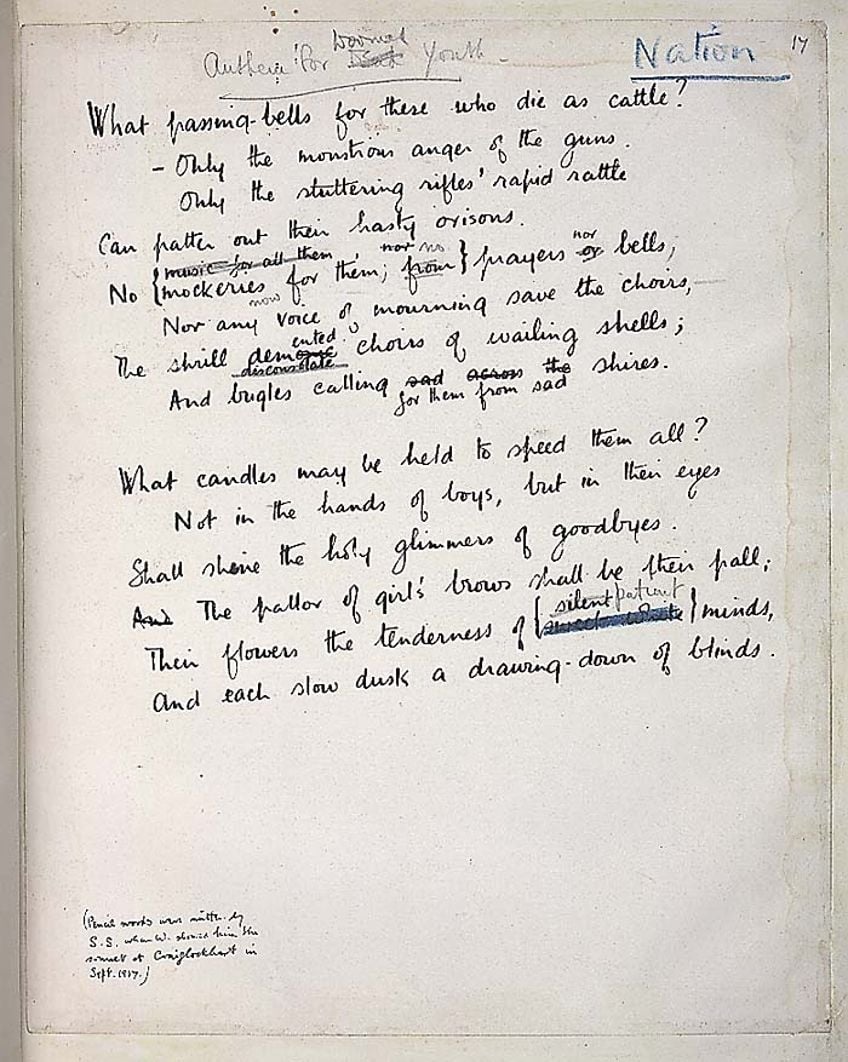
The Colossus (1960) by Sylvia Plath
| Date Published | 1960 |
| Type of Poem | Free verse |
| Rhyme Scheme | None |
| Meter | None |
| Topic | Fathers |
The Colossus is one of the poems that Sylvia Plath wrote about her father. Many of Plath’s poems were deeply personal and fell within a genre known as confessional poetry. This allows the personal experiences of the poet to be put on full display for all to see, and this particular poem is a fantastic example of that.
Poems with alliteration use this technique for many reasons, and in this case, it is used to create a sad image. Lines like “little ladders with glue pots and pails of Lysol/I crawl like an ant” shows the joint repetition of the “p” and “l” sounds used in conjunction with one another to produce a rhythmic effect. This aids in the sorrowful image that is being produced.
This little look at an alliterative list should, surely and succinctly, have provided a poem or two to tell a tale about how alliteration can be used in poetry. There are many different ways that this poetic device can be used to great effect in poetry, and so, hopefully, you have gained some insight into how and why alliteration poems do what they do. There are many other alliteration poems out there though, because when it comes to poems using alliteration, the full list will be impossibly long and definitely worth a perusal or two if you happen to like poems with alliteration.
Frequently Asked Questions
What Is Alliteration?
Alliteration is a poetic device. It can be found in far more than poetry, but it does tend to have a strong association with both poetry and the lyrics in music. This device entails the repetition of consonant sounds. This means that it involves the repeating of sounds that are not vowels. So, any repetition of letters that is not one of the five vowels counts as a form of alliteration. This is a very common poetic device.
Why Is Alliteration Used in Poetry?
This technique is used for a wide array of reasons. There is no singular reason for alliteration in poetry. It could, simply, be used to create a sense of rhythm, as an example of alliteration in poetry will make said poetry roll off the tongue in a far more pleasing manner. However, poems with alliteration might also use this poetic device to highlight something or to add musicality to the phonetics of the poem.
Which Famous Poets Made Use of Alliteration?
When it comes to poets who have made use of alliteration, it may be easier to ask which poets have not made use of alliteration in their poems. Figures from William Shakespeare to all of the Romantics, to Emily Dickinson and Sylvia Plath have made use of poems with alliteration. The device is so common that practically every poet has used it unless they very specifically set out to not use it. However, figures with highly musical poetry, like Edgar Allan Poe, are known to have used it to a far greater extent than the average poet.
What Are the Most Famous Poems Using Alliterations?
There are so many poems using alliterations that it can be difficult to point to only a handful of poems. However, there are a number that are worth pointing towards, such as The Raven (1845) By Edgar Allan Poe, Because I Could Not Stop for Death (1890) by Emily Dickinson, and Anthem for Doomed Youth (1920) by Wilfred Owen. One could also state that an example of alliteration in poetry is incomplete without looking at the highly alliterative children’s poems, like Peter Piper (1813) by John Harris. Alliteration is used in poetry for a variety of reasons, and because of this, it can be found in a vast array of poems, and whittling it down to a handful is a difficult thing to do.
What Is the Difference Between Alliteration and Consonance?
The difference between these two terms is quite a pedantic one. Technically, alliteration refers to repetition at the start of a word, and consonance refers to repetition throughout a word. However, most use alliteration to mean consonance and common usage often trumps technical definition. So, we can often use these two terms somewhat interchangeably with one another because most do not know the difference between them.
Justin van Huyssteen is a freelance writer, novelist, and academic originally from Cape Town, South Africa. At present, he has a bachelor’s degree in English and literary theory and an honor’s degree in literary theory. He is currently working towards his master’s degree in literary theory with a focus on animal studies, critical theory, and semiotics within literature. As a novelist and freelancer, he often writes under the pen name L.C. Lupus.
Justin’s preferred literary movements include modern and postmodern literature with literary fiction and genre fiction like sci-fi, post-apocalyptic, and horror being of particular interest. His academia extends to his interest in prose and narratology. He enjoys analyzing a variety of mediums through a literary lens, such as graphic novels, film, and video games.
Justin is working for artincontext.org as an author and content writer since 2022. He is responsible for all blog posts about architecture, literature and poetry.
Learn more about Justin van Huyssteen and the Art in Context Team.
Cite this Article
Justin, van Huyssteen, “Alliteration Poems – Discover Famous Poetry Examples.” Art in Context. October 30, 2023. URL: https://artincontext.org/alliteration-poems/
van Huyssteen, J. (2023, 30 October). Alliteration Poems – Discover Famous Poetry Examples. Art in Context. https://artincontext.org/alliteration-poems/
van Huyssteen, Justin. “Alliteration Poems – Discover Famous Poetry Examples.” Art in Context, October 30, 2023. https://artincontext.org/alliteration-poems/.




